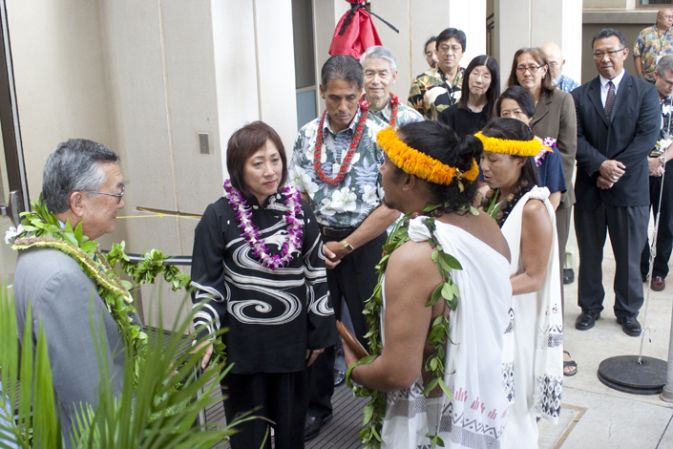Kapolei Judiciary Complex Dedicated
Posted on May 29, 2010 in Featured News
 Guided by Kahuna Braven Kalama Cabigon, Chief Justice Ronald Moon (left), Senate President Colleen Hanabusa (right), and many others who played a significant role in the construction of the Kapolei Judiciary Complex untied the maile at the main entrance of the courthouse during the May 28 dedication ceremony.
Guided by Kahuna Braven Kalama Cabigon, Chief Justice Ronald Moon (left), Senate President Colleen Hanabusa (right), and many others who played a significant role in the construction of the Kapolei Judiciary Complex untied the maile at the main entrance of the courthouse during the May 28 dedication ceremony.
The official dedication ceremony of the Kapolei Judiciary Complex was held on Friday, May 28 against the backdrop of the Waianae mountains, the colors of which were mirrored in the matching green, brown and blue colors of the building’s roof.
The ceremony began at 1:30 p.m. with a welcome from the Mistress of Ceremonies, newscaster, and Kapolei resident Paula Akana, followed by a mele oli, or Hawaiian chant, by Braven Kalama Cabigon.
The featured speakers were Senate President Colleen Hanabusa, Representative Sharon Har on behalf of the Speaker of the House, Administrative Director Thomas Keller, Lt. Governor James Aiona, Jr. on behalf of the Governor, Hawaii State Foundation on Culture and the Arts Oahu Commissioner Peter Rosegg, and Chief Justice Ronald Moon.
The traditional parting of the maile lei concluded the ceremony.
As with most celebratory occasions of this sort, smiles abound on the faces of the 200-or-so employees, judges, juvenile detention staff, court administrators, community leaders, elected officials and others present.
Attendees had many reasons to smile about the new complex. Many of the employees seen at the ceremony who relocated to Kapolei may have been smiling because they no longer have to work in overcrowded conditions. The family court judges may have been smiling because they have enough courtroom space so that they and opposing parties are no longer in close proximity to each other. The detention facility staff may have been smiling because the juveniles are now housed in a bigger, safer and more modern, comfortable and spacious facility. Court administrators may have been smiling because they can make plans for the much-needed space in the Honolulu court building that has been freed up. Community leaders may have been smiling because the residents of West Oahu who are involved in Family Court matters no longer have the hardship of traveling to Honolulu. Elected officials may have been smiling because the difficult decision to appropriate money has been actualized in a court complex that will eventually help facilitate access to justice for all Oahu residents.
A new court complex that will facilitate access to justice for all Oahu residents has long been a goal of Chief Justice Moon, who has said, “Through the eventual phasing-in of a full service court operation at Kapolei, the Judiciary will provide a complement of court services appropriate to a major urban area. This is consistent with our philosophy that judicial services must be conveniently available to all.”
Chief Justice Moon should be pleased to see the Kapolei Judiciary Complex become a reality because it has been a long time coming. In fact, it’s taken over 20 years and $124.5 million to get the 123,118-square-foot courthouse and 52,306-square-foot juvenile detention facility built, which would not have been possible if not for Chief Justice Moon’s determination to provide a safer, more secure, and operationally conducive and efficient facility in which the public, employees, parties, attorneys and all other court users can conduct their business.
In recognition of this significant achievement, the Twenty-Fifth Legislature adopted Senate Concurrent Resolution No. 38 recommending that the Kapolei Judiciary Complex be renamed the “Ronald T. Y. Moon Judiciary Complex.” A renaming event will be held later this year.
Here are a few more facts about the complex:
- the courthouse has 12 non-jury courtrooms and one jury courtroom
- there are 66 beds in the detention facility
- the new facility is significantly reduced in size from the original concept
- sustainability or “green” features include light pollution reduction, water efficient landscaping, water use reduction, no HCFCs used in construction, recycled and local content building materials, low-emitting indoor materials, use of natural lighting, and thermal comfort monitoring and control
- all of the wood used throughout the building is cherry, not koa to keep expenses down and for sustainability purposes
- 280 Family Court, Juvenile Detention Facility and Waianae District Court employees work in the complex
- 81 Family Court employees remain at the courthouse in downtown Honolulu
- there is wireless Internet connectivity for public use on the second, third and fourth floors of the courthouse
- the courtrooms are equipped with state-of-the-art equipment that, in addition to recording proceedings, may be used for video conferencing
- all plants used to landscape the property are indigenous to Hawaii
- the building panels contain Native Hawaiian cultural symbols including engraved dots representing the five constellations used to navigate by ancient Polynesian voyagers
